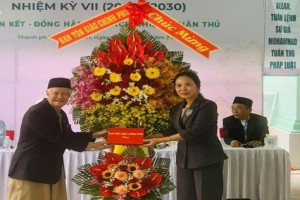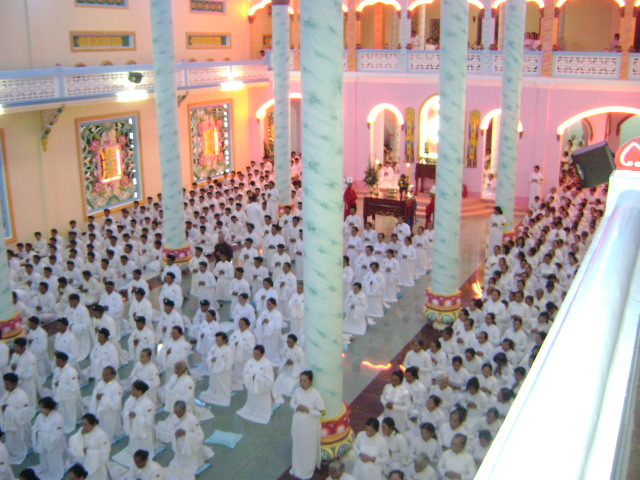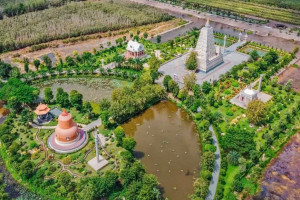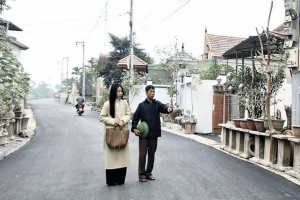Đa Phước temple or Đà Lạt temple is about 7 km East from the center of Đà Lạt. This temple belongs to Caodai Tây Ninh. It is the biggest temple of Cao Dai in Vietnam now.
This temple was built in 1938 by Student - Priest Ngọc Thọ Thanh (religious name Trần Văn Ngọ), a Caodai dignitary from Tây Ninh, was sent to carry out missionary work here. In 1941, Cao Dai believers restored the temple and built the Mother Goddness Shrine. In 1942, Caodai Tây Ninhcontinuously sent the dignitaries to Đà Lạt in order to increase missionary work in the Central Highlands. Therefore, in early 1950s, the Sacerdotal Council of Caodai Tây Ninh planned to upgrade Đà Lạt temple to become the center of Caodaism in the Central Highlands. In 1952, Phạm Công Tắc himself chose the place of temple and took part in groundbreaking ceremony of new temple. The temple was designed according to the second graphical design. It was approved by Phạm Công Tắc (Tây Ninh Holy See was designed according to the first graphical design) Any branch of Caodaism would like to build its temple, he comes to theSacerdotal Council’s Board of Architecture to choose graphical design which is the most suitable to his area. The Sacerdotal Council would send the workers to build and decorate temple as the regulations of theSacerdotal Council. Because of difficult condition at that time, the construction of Đà Lạt temple was temporarily stagnated.
In 1973, the headquarter of Tuyên Đức - Ninh Thuận religious region (a Caodaism administrative unit equals to 5 provinces) was set up in Đà Lạt. Since then , Caodaism also developed certainly here. Up to 1975, it had 16 religious villages and 6.500 believers . After 1975, the organization system of Caodaism was temporarily disbanded so dignitaries, sub - dignitaries and believers practiced religious activities at home. Caodaism in Đà Lạt was allowed to form a Management Board and maintained the normal religious activities. In 1997, Caodai Tây Ninhwas recognized the legal person status by the State so that the dignitaries and followers here were happy. They believed in our Party and State’s religious policies. They actively took part in local movements. Now, Caodai Tây Ninhhas 5 religious families with 54 dignitaries, sub-dignitaries and over 8000 believers .
In 2005, with the determination of believers in Đa Phước religious family, Đà Lạt temple was rebuilt according to the second graphical design of Tây Ninh Holy See. On June 17th, 2005 the license of the temple construction was approved with the area of construction is 1.627 m square and the total area is 14.774 m square with a value of 7 billion VND, not including the service of the thousands of the workers and followers. The temple was officially opened on July 30th 2010 and has become the biggest Cao Dai temple in Vietnam as well as in Đà Lạt
Temple is located on the hill with many trees. The first beautiful impression for visitors is the harmonious scene between religious architecture and nature. Its design is similar to Tây Ninh Holy See’s design with three branches: Hiệp Thiên Đài (the Legislative Body) is front, Cửu Trùng Đài (Executive Body ) is middle and Bát Quái Đài (the Eight-Trigram Palace) is behind. From front view, this temple looks like small Tây Ninh Holy temple
There are 4 columns to be called Long Hoa in the main front entry. Each side has two parallel columns, one is carved with a red dragon, and one is carved with a lotus. Both are symbolized Long Hoa Great Festival which is a changing period of evolution of mankind. To enter the temple visitors have to walk over 5 steps which represent the Five Great Religions and five mankind’s evolution steps: Human, God, Saint, Fairy and Buddha.
After walking over the five steps, visitors enter Tịnh Tâm Điện area. The picture of Three Caodaism Saints signing Thiên Nhơn Accord is front. This picture is similar to the picture in Tây Ninh Holy See. The interior room is called the Main Shrine. Behind the picture of three Caodaism Saints and opposite to God’s altar is the altar Hộ Pháp. In this temple there is not statue of Phạm Công Tắc same as in Tây Ninh Holy See.
Remarkably, Hiệp Thiên Đài has 2 high floors of bells and drums, each floor is 18m high. It consists of five stories . Its design is similar to Catholic bell- tower. Cửu Trùng Đài is in the middle of the Main Shrine and connecting Hiệp Thiên Đài with Bát Quái Đài. This area has 6 columns standing on a big red lotus in 2 sides, which are not similar in Tây Ninh Holy See. Bat Quai Dai is at the end of the temple with eight dragon - decorated columns arranged the Eight Trigrams and a five-step altar: The first step is a picture of Divine Eye, Thai Cuc candle below; the second is the altar of three Heads of Religion including Gautama Buddha, Lao Tzu and Confucius. The third is the altar of Bodhisattva Avalokitesvara, Spiritual Pope Li Tai Pi andGuan Yun Changwho represent the Three religions in the Third Great Universal Religious Amnesty The forth is the altar of Jesus who is the head of Christianity. The fifth is the altar of the head of Jiang Ziya
Nowadays, Đa Phước religious family continues to build the Shrine of Goddness Mother. Đa Phước temple is an unique religious architecture. It makes Đà Lạt more and more beautiful
(Đà Lạt temple is viewed from a far distance)
(inside main shrine of the Oratory)
Minh Tri








